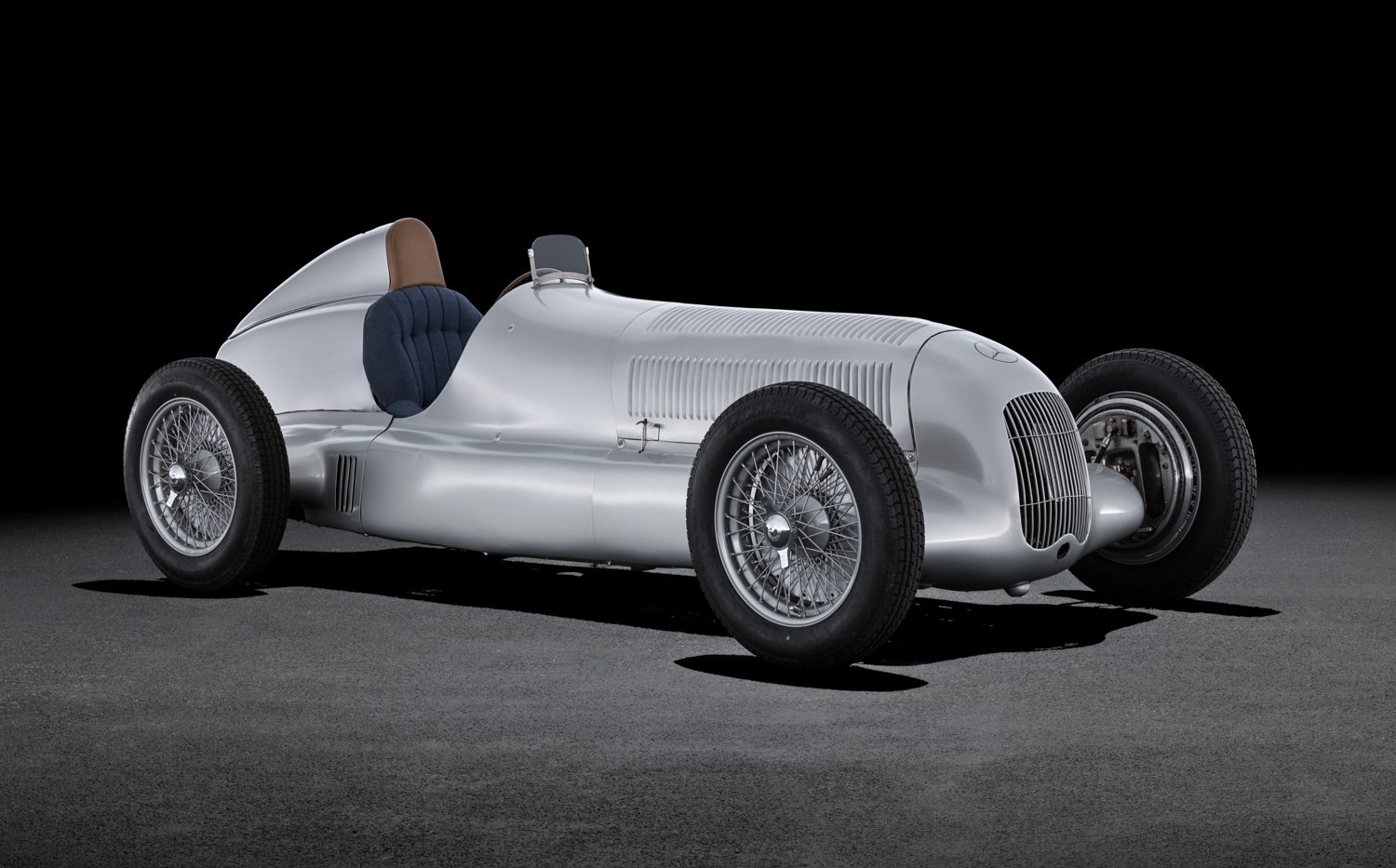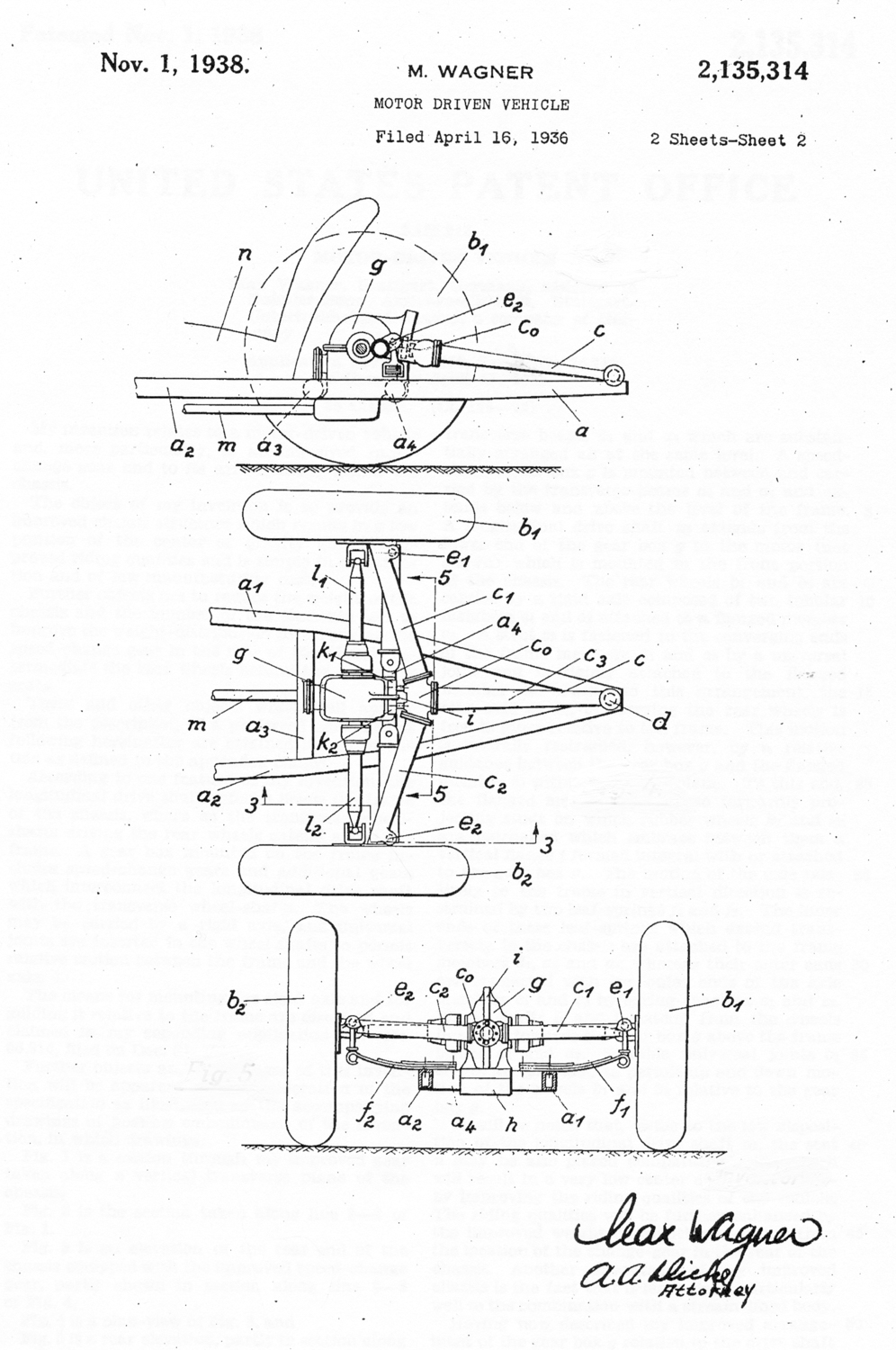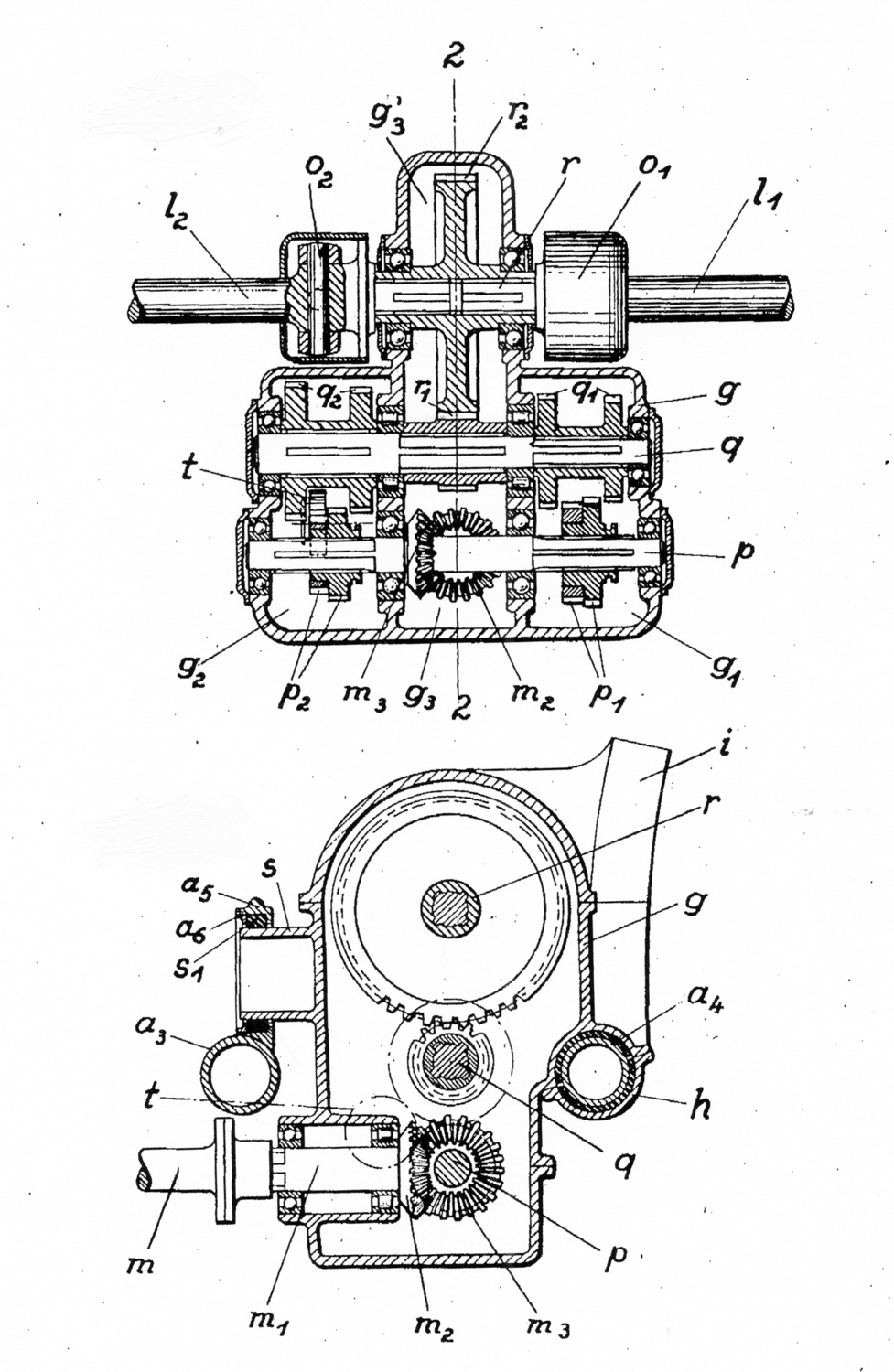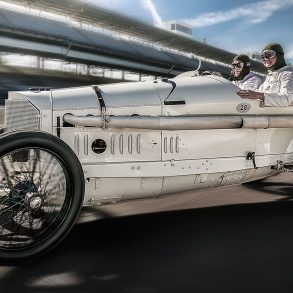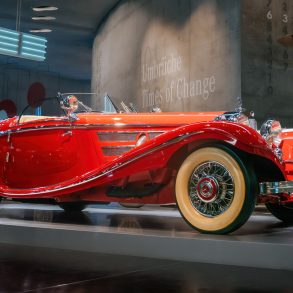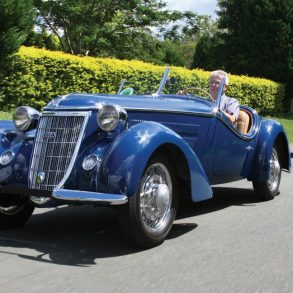Nineteen thirty-five was an excellent Grand Prix season, the best against strong and varied opposition that Mercedes-Benz enjoyed in Year Two of the new 750-kilogram G.P. formula. In its second season the W25 was fully proven and raced as part of a team that was at last operating as a team, driven by two absolute aces in Rudy Caracciola and Luigi Fagioli.
Caught napping by the Germans, who had been quicker to see the potential of the new rules, Alfa Romeo and Maserati introduced new and faster cars in 1935 that threatened to be sterner rivals in 1936. And the meteoric Bernd Rosemeyer was displaying uncommon skill at the wheel of his Auto Union. Major changes in the Mercedes-Benz equipment for the formula’s third year were clearly needed.

For 1936 the plan was to build an “SSK” version of the W25, a car that would be lower and shorter, especially at the rear. This would make it inherently lighter so it could be equipped with a new and more powerful engine without exceeding the weight limit. Conceived for this purpose by the Albert Heess engine group was a 60-degree V-12 using the same construction techniques as the M25 eight. Cylinder blocks were welded steel with integral four-valve heads.
The first of these D-series engines was designated DAB because it had the same dimensions as the latest eight, the M25AB, 82 x 88 mm for 5,577 cc. The design office estimated that it would deliver 516 bhp on 2B fuel, the usual racing blend, and 598 bhp on W.W., pure alcohol.
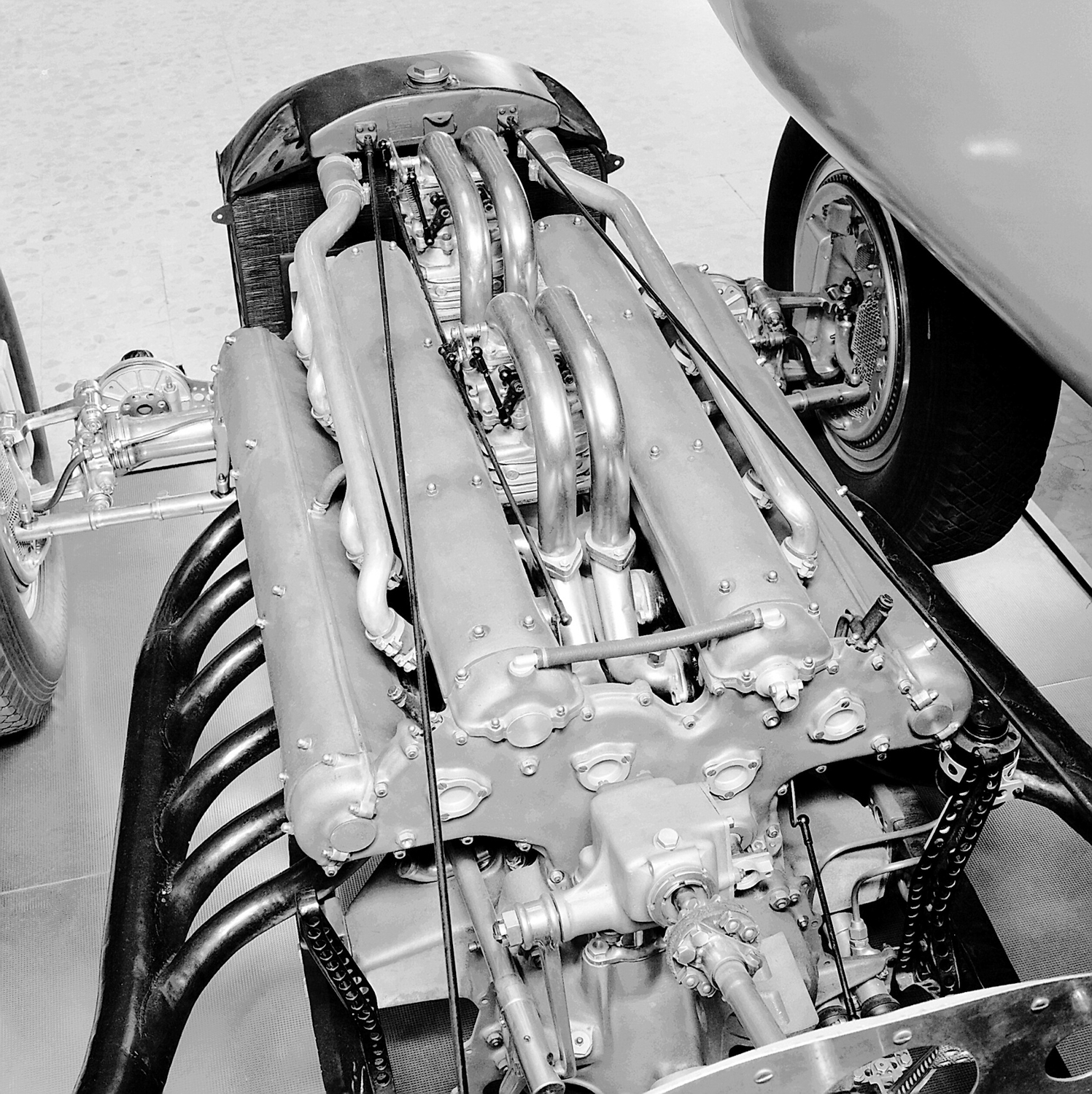
In late summer of 1935 the first DAB engine was found disappointing, not in its power but in its weight. It scaled 650 pounds, almost 250 more than the various M25 eights. This only confirmed that the steel-cylinder construction, so suitable for the straight eights. After this discovery, dynamometer development of the DAB engine was slowed. In 1936 an early test report showed that it developed 570 bhp at 5,500 rpm, close enough for comfort to the design-office forecast.
In spite of the V-12 engine’s heft it was installed in a new 1936 chassis to find out if the resulting racer could be under the weight limit. Engineer Rudolf Uhlenhaut said that it could, but it was not well-enough balanced to be a successful road-racer: “Although the new car was within the 750-kilogram limit, it had too much weight at the front end. It was quite good for setting records on a straight road but quite unsuitable for the Nürburgring, for example.”
A straight-eight would have to be the solution. Jumping to the next letter of the alphabet, a decision was taken in mid-September 1935 to build an E-series engine, altering the letter/number sequence of its designation to make it the ME25.
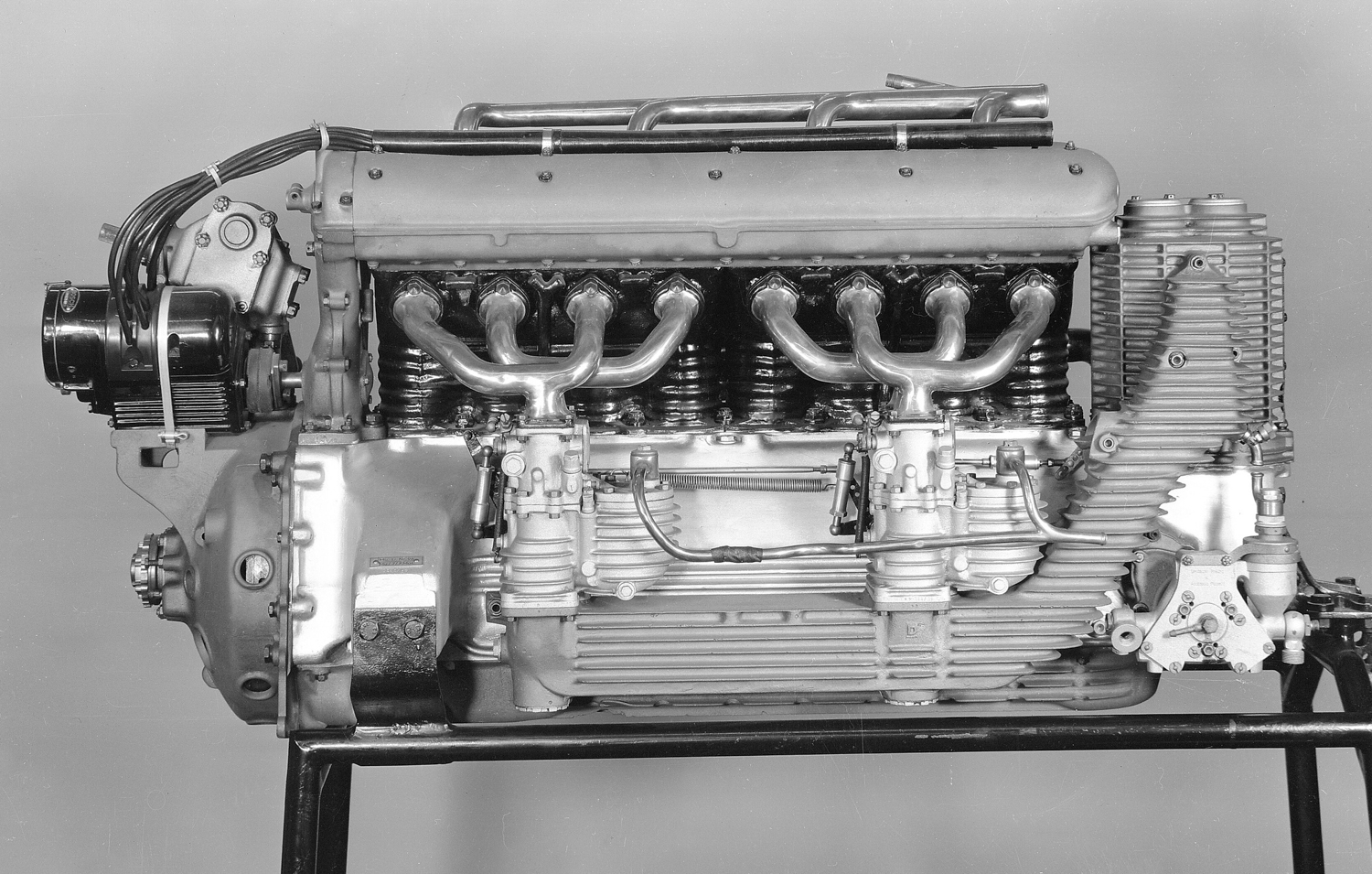
By the end of November the Heess staff had completed work on this final expansion of the size of the original M25 engine within its 95-mm cylinder-bore spacing. Stroke, crankshaft, connecting rods and bottom end generally remained at the maximum to which they had already been stretched in the M25C while the bore was enlarged by 4 mm. Its dimensions were 86 x 102 mm for 4,740 cc. New cylinder forgings for this larger-bore engine allowed a valve-size increase to 37 mm.
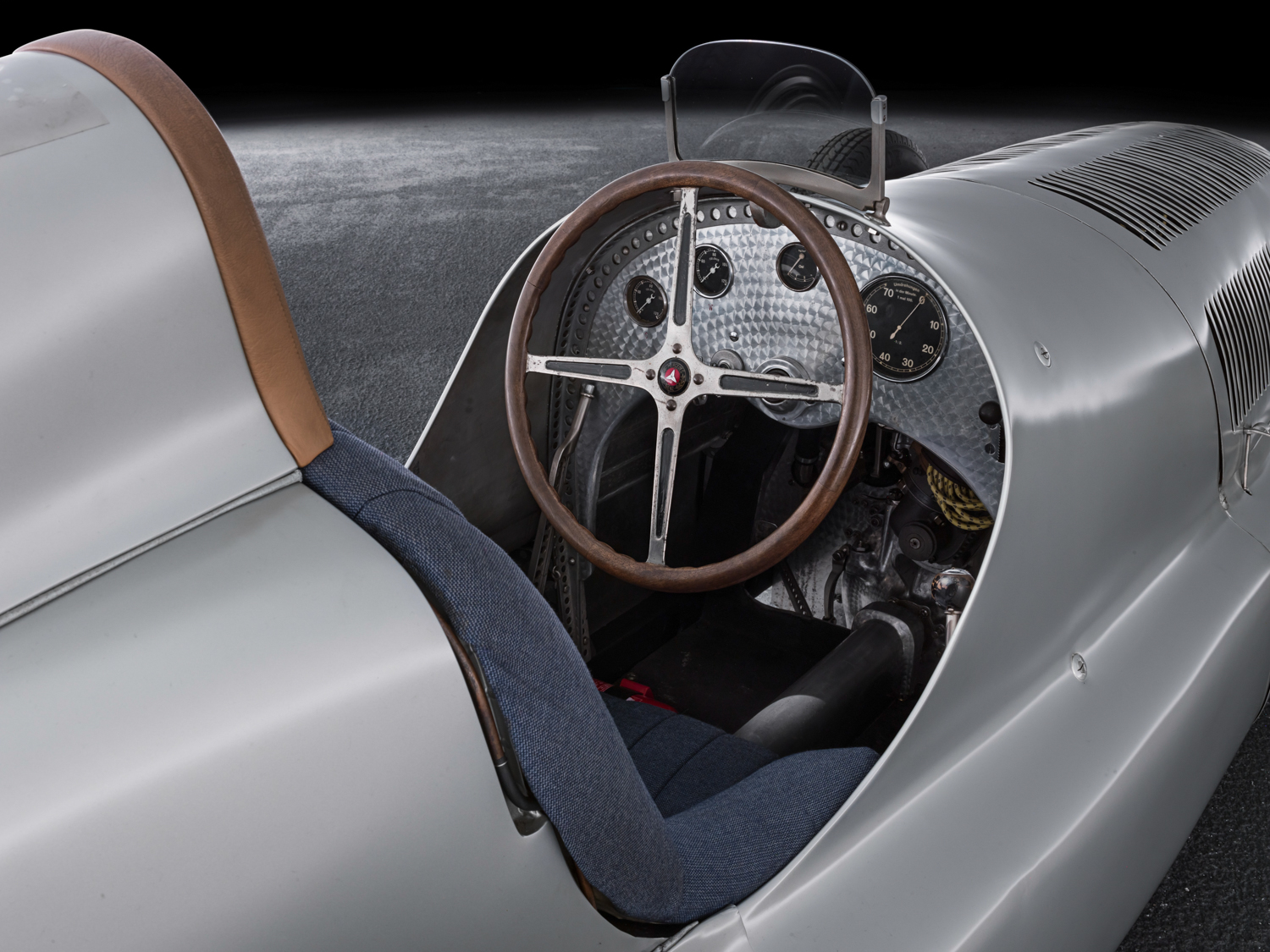
A new supercharger was designed with an enlargement in rotor diameter from 106 to 125 mm. Blowers of both 240-mm and 255-mm rotor lengths were prepared, the smaller one considered the standard size. They continued to use steel rotors while experiments with light-alloy rotors proceeded. New larger 36 mm intake-manifold sets were also readied for the ME25. The blower boosted through two carburetors and manifolds that were available in different diameters to tune the cars to specific circuits.
Orders were issued for the production of six of these new engines with six spare crankshafts, the parts to be ready on January 20, 1936 and dynamometer testing to begin on February 15th. Though a late effort with a high element of risk, it was the only course open to the team. A later increase by four brought to ten the total of ME25 engines made. As a backup, all the available M25B and M25C engines were also made race ready for 1936.
M25C power units were used in tests to propel the first of the five new racing cars that were built, called the “Model 1936” or, more familiarly, the “short car”. The author prefers and uses the suitable designation of “W25K”. Two chassis were assembled and two were in component form in early October 1935 when testing began.
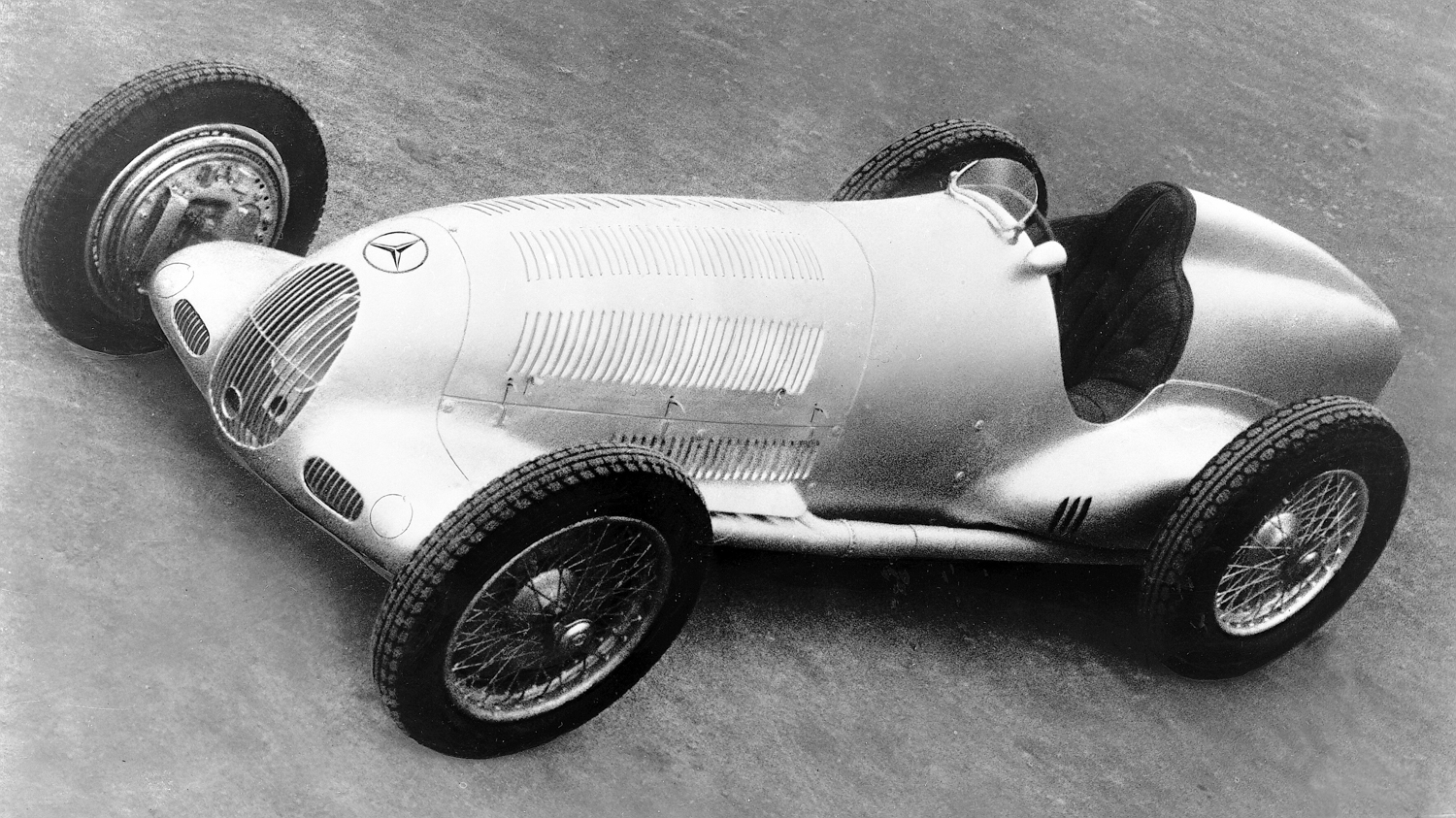
Ex-Benz man Max Wagner continued to direct the chassis-design side, directly under chief racing engineer Max Sailer and his still-youthful deputy, Fritz Nallinger. Seconded to Alfred Neubauer’s Sports Department to give liaison and technical assistance was an Untertürkheim veteran: ex-riding-mechanic Jakob Krauss.
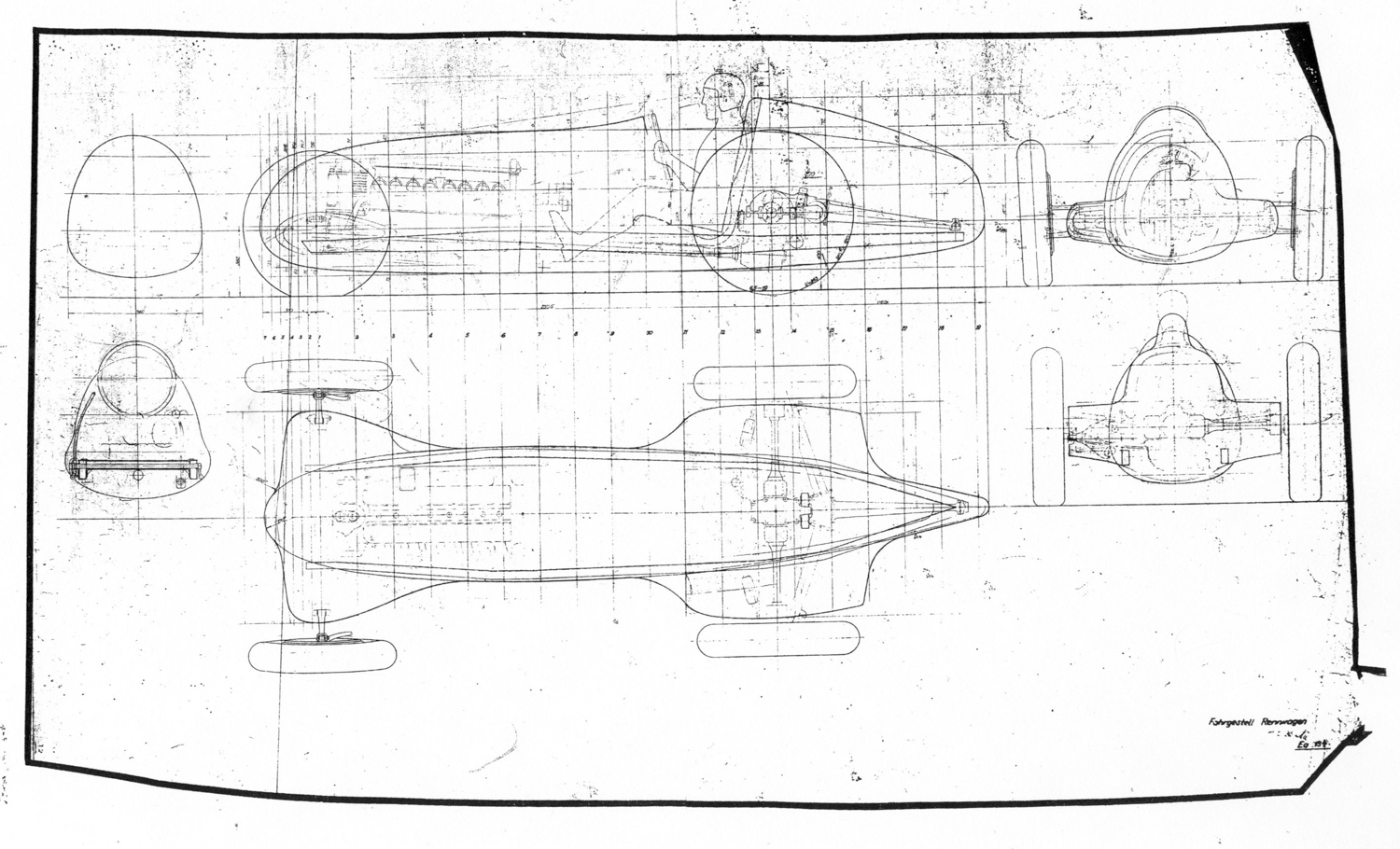
The W25K incorporated several major changes. Its wheelbase was shortened by more than 10 inches to 97 inches, front and rear track remaining at 58 and 56 inches. This was made possible by a completely new transaxle design that had been in the works since the winter of 1934-35.
The new transaxle further lowered the car’s propeller shaft by placing the two gearbox shafts in a transverse plane below the final drive gears—a radical departure from the normal longitudinal shaft axis. Stacking these shafts one above the other and laterally beneath the differential cleared—for a lower-seated driver—the space ahead of the rear axle that the transmission formerly occupied.
The drive from the propeller shaft entered the gearbox at the center of its bottom shaft through a pair of bevel gears that could be varied one tooth or so either side of a one-to-one ratio. Four speeds and reverse were spaced along the two transmission shafts, to the left and right of the central bevel, still selected by sliding the gears into engagement with each other.
At the center of the upper shaft a pair of spur gears took the drive to the differential. These gears provided the normal ratio reduction, for example 3.69:1. On the W25K the differential choice was between a fully locked rear end, with no differential action at all, and the ZF self-locking cam-action diff.

First runs in the chassis took place in the late summer of 1935 in a W25-based mule at the ‘Ring and Bern circuit. They showed that the transaxle tended to become too warm. Attention was given both to its cooling, by means of ducting, and to its oil capacity, which initially was slightly more than half that of the 1935 transaxle. Monza trials also showed the need for a redesign giving higher torque capacity throughout the gearbox.
No longer were heavy pivots for swing axles attached to the sides of the differential. The W25K had an entirely new rear suspension. Toward the end of 1935 the W25 was finding it increasingly difficult to apply its steadily greater power to the ground. The shorter wheelbase of the W25K was intended to help by shifting more weight rearward.

The added power also aggravated another attribute of the earlier W25: if the rear end broke away in a corner it was extremely difficult to catch. The swing axles, judged at least partially at fault, were given up in favor of a design that worked well enough before: a solid axle.
It was a solid axle with a difference. To these Daimler and Benz men, with roots deep in the origins of motoring, it was an axle like those used on their Grand Prix models of 1908, like the racing Mercedes of 1913 and the Blitzen Benz. It was a dead axle, joining together wheels which were driven not by chains, this time, but by open shafts, each with two universal joints. It was an independent re-invention of what a later generation would come to call “de Dion” rear suspension after the French producer that used it in production models in the early years of the century.
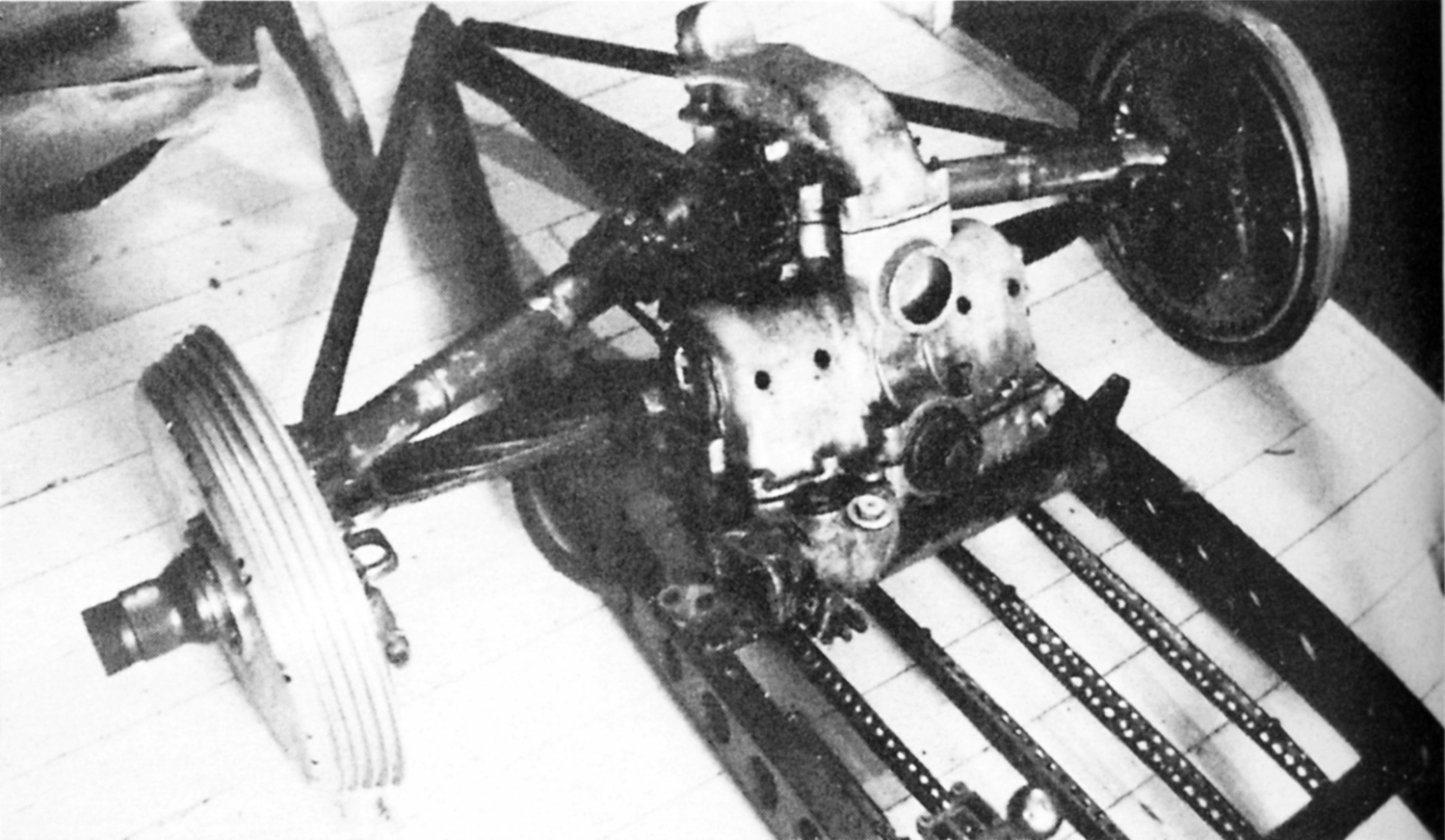
The axle was fabricated of steel tubing in the shape of a broad-topped Y. The upper arms of the Y reached out, in plan view, to the wheel hubs, while the tail extended rearward to a ball pivot anchored to the rear end of the frame. The latter tapered inward to a point at that junction. This pivot was a critically important location point, taking both braking torque and transmission-drive thrust.
This unique de Dion configuration was adopted, said Rudolf Uhlenhaut later, because “Mr. Wagner wanted a good-looking car.” This was achieved so well that the dead axle was completely concealed. Indeed many observers still believe that Mercedes-Benz adopted the de Dion axle for racing in 1937 rather than 1936. It only became visible, in a new configuration, in 1937.
An additional means of guiding the solid axle was needed to cope with the lateral forces experienced in cornering. This guidance was supplied by a vertical fin fixed to the back of the transaxle casing. Within the crotch of the axle Y, riding up and down the sides of this fin, were two rubber-faced rollers attached to the axle tube.
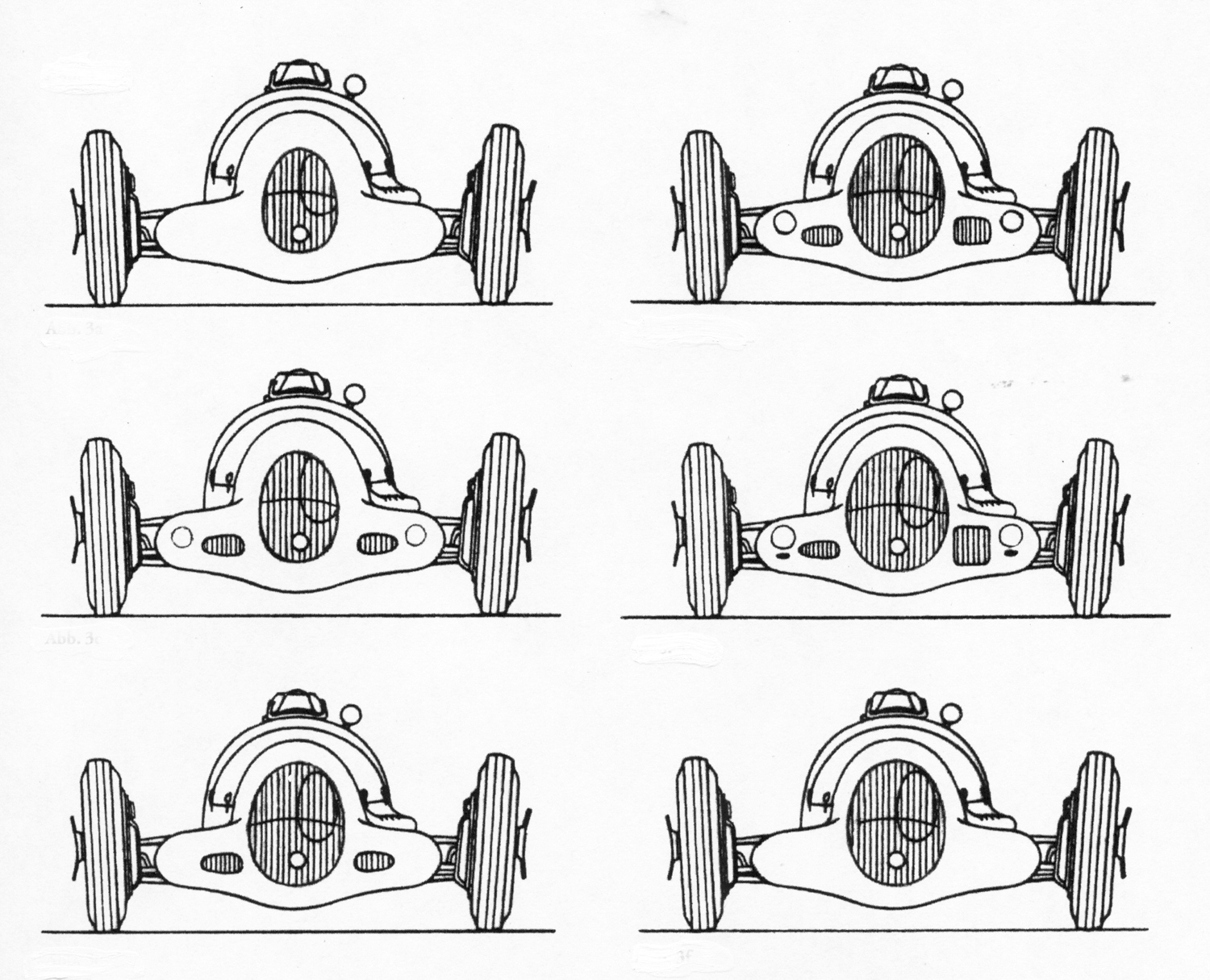
Under the supervision of Dr. Maruhn, a theoretician who ran a general research department at Untertürkheim, a rig was built to test the rollers for durability. Under moderate load the first one lasted only 12 minutes. During tests of the first car at Monza in December they continued to be troublesome, leading to suggestions for armoring the rubber, enlarging the rollers and isolating the guide fin from the heat of the differential.
During the 1936 season the rollers were abandoned in favor of a steel-sided slot in the back of the transaxle, in which slid a bronze block attached to the crotch of the axle Y by a projecting ball pivot. This would set a style for de Dion lateral guidance that would last well into the 1950s.
Quarter-elliptic leaf springs with friction shock absorbers were retained at the rear of the chassis. The latter was founded on an extensively lightened box-section frame like that of the 1935 model. The front suspension was carried over almost unchanged within its tubular crossmember. Thanks to all the changes, especially the new transmission, the car’s center of gravity was lowered a remarkable 5.9 inches.
Brakes, to which screened cooling-air inlets and outlets were added during 1935, were also transferred to the W25K. For better cooling the rear-brake vents were fitted with a coarser mesh screen. Drums were given finer finning. Each brake was equipped with two grades of Iurid lining corresponding to the different workloads of the two shoes.
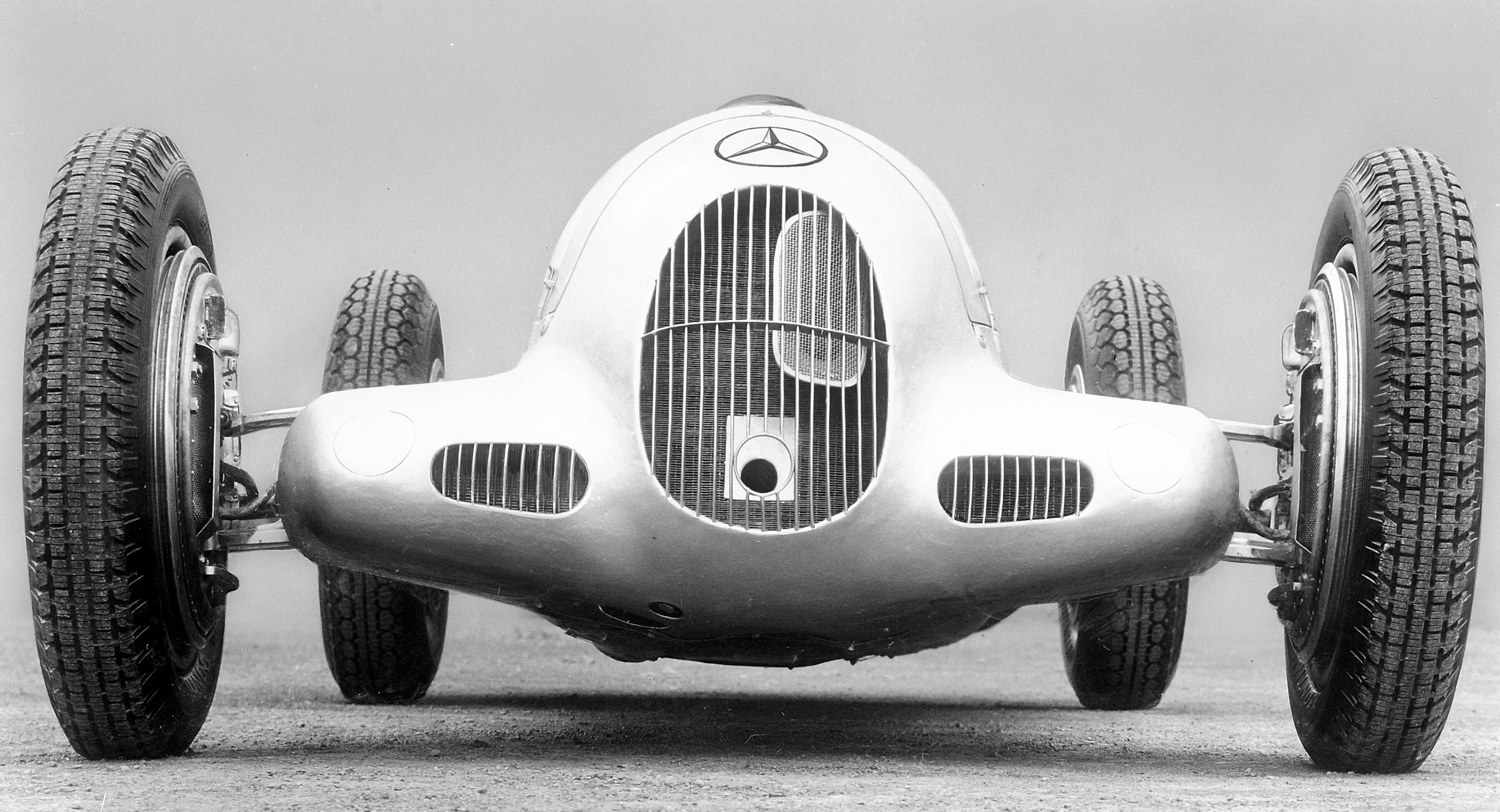
Designed by Josef Müller, the new body wrapped around this radically lowered car had an almost circular cross section, a long, slim tail and deep fairings concealing the front suspension and the adventurous new rear suspension. It was one of the handsomest racing cars ever built. When the cars first appeared for a presentation at the Berlin Auto Show in February they had a single oval radiator air entry. After testing this was supplemented by two additional grilles in the front fairings.
The left-hand grille was enlarged early in 1936 to accommodate an oil cooler, fitted to a Mercedes-Benz G.P car for the first time. It was judged so successful that oil coolers were added to the 1935 cars that were being carried over to the new season. Exhaust piping was newly positioned down at ground level, sweeping back on the left below the rear axle.

One reason the 1935 W25s were still on hand, apart from their value as training and backup cars, was that the cockpit of the shortened Model 1936 was so tight that Manfred von Brauchitsch couldn’t drive it comfortably. “In a car calculated down to the gram,” said Alfred Neubauer, “additional reserves for an extra-large driver are naturally impossible.” Offered one of the older cars for the season, Manfred instead contrived to squeeze himself into the new one except in the Eifelrennen, in which he drove a modified 1935 car.
After the first trials, changes were made to the body to give the drivers more protection from the wind. One W25K went to the Zeppelin wind tunnel at Friedrichshafen for an aerodynamic evaluation. Monza tests showed the need for an enlargement of both the main grille opening and the radiator itself.
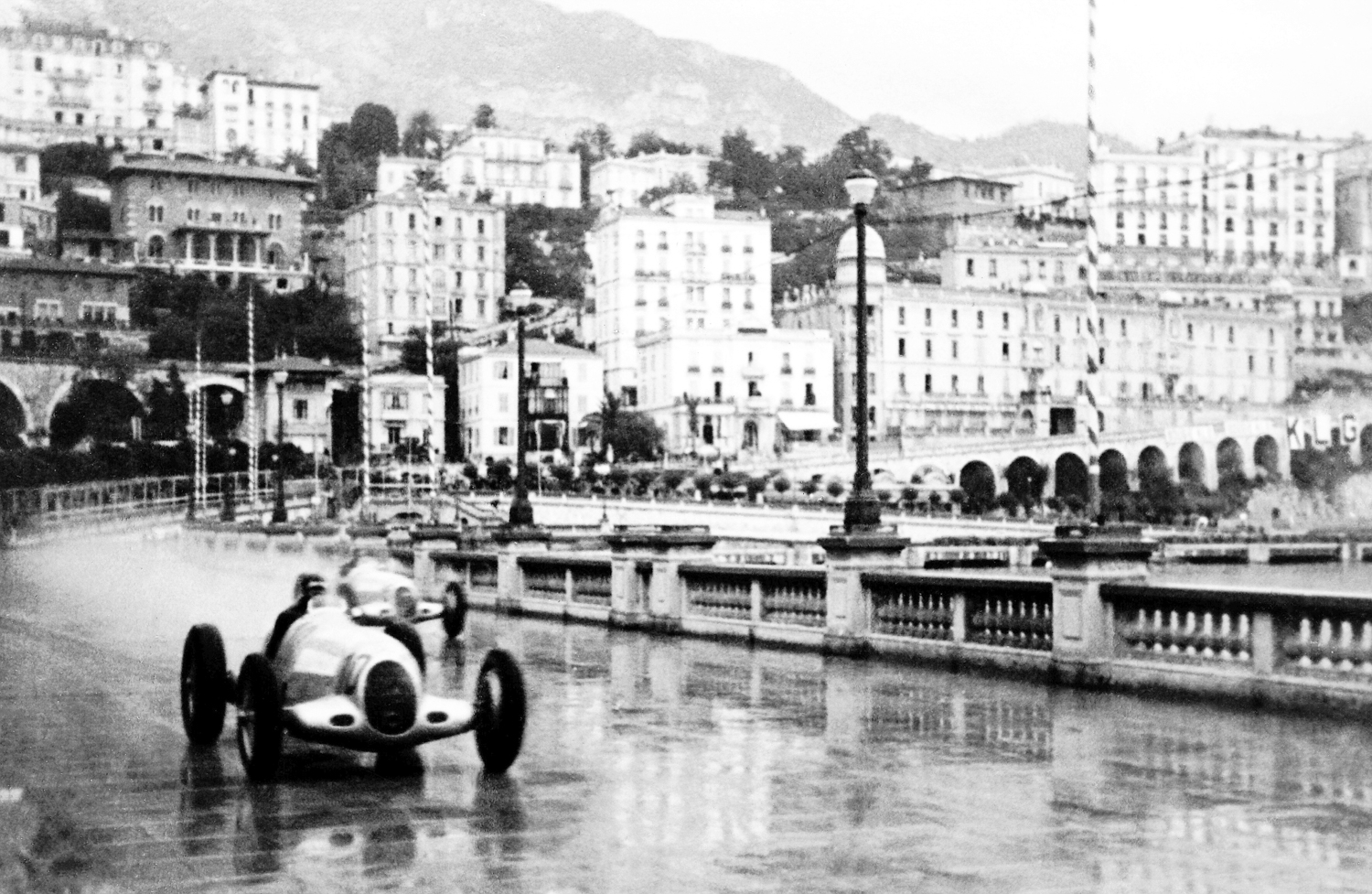
All these early tests were carried out with M25C engines. In late February the first ME25 went on one of Georg Scheerer’s two dynamometers for a durability test. Its uncorrected output was 430 bhp on the normal fuel blend, equal to 449 bhp at 5,000 rpm with the standard corrections applied.
With a compression ratio of 8.65:1 and the 255-mm-long supercharger the ME25 gave its best-ever power of 473 bhp at 5,800 rpm, recorded during the Summer of 1936. Its typical output as prepared for racing with the 240-mm blower and a compression ratio of 8.17:1 was 453 bhp at 5,800 rpm with maximum torque of 465 lb-ft at 3,000 rpm. This was achieved on a boost pressure of 14.5 psi, exactly 1.0 bar.
Output was excellent from an engine that was even lighter than the M25C at 465 pounds. For the first time a Mercedes-Benz racing engine produced more than one horsepower per pound.
To spectators at Monte Carlo on April 13 for the first Grand Prix of 1936 nothing seemed to have changed except the smooth shape of the silver cars on the front row of the grid. Caracciola tiptoed through a rainy race to win after most of his teammates were sidelined by crashed at the chicane.

Not until they arrived at the fast, hot Tripoli circuit in May did the drivers have a chance to extend fully the W25K with its new ME25 engine. Comparing it with the same engine in the 1935 chassis and body, albeit with slightly different gear ratios, both had the same 175-mph maximum speed.
Caracciola complained of understeer, which was reduced by replacing the locked differential with a ZF unit. The drivers were generally dissatisfied with both the roadholding and the steering, which still mustered a strong steering-wheel kick-back.
Technically the Tripoli race was as inconclusive as Monaco. One of the 255 mm blowers failed in practice so all the cars were switched to the 240 mm unit for the race. One car, that of new man Louis Chiron—a Monegasque and a close friend of Caracciola—suffered minor troubles that retired it.
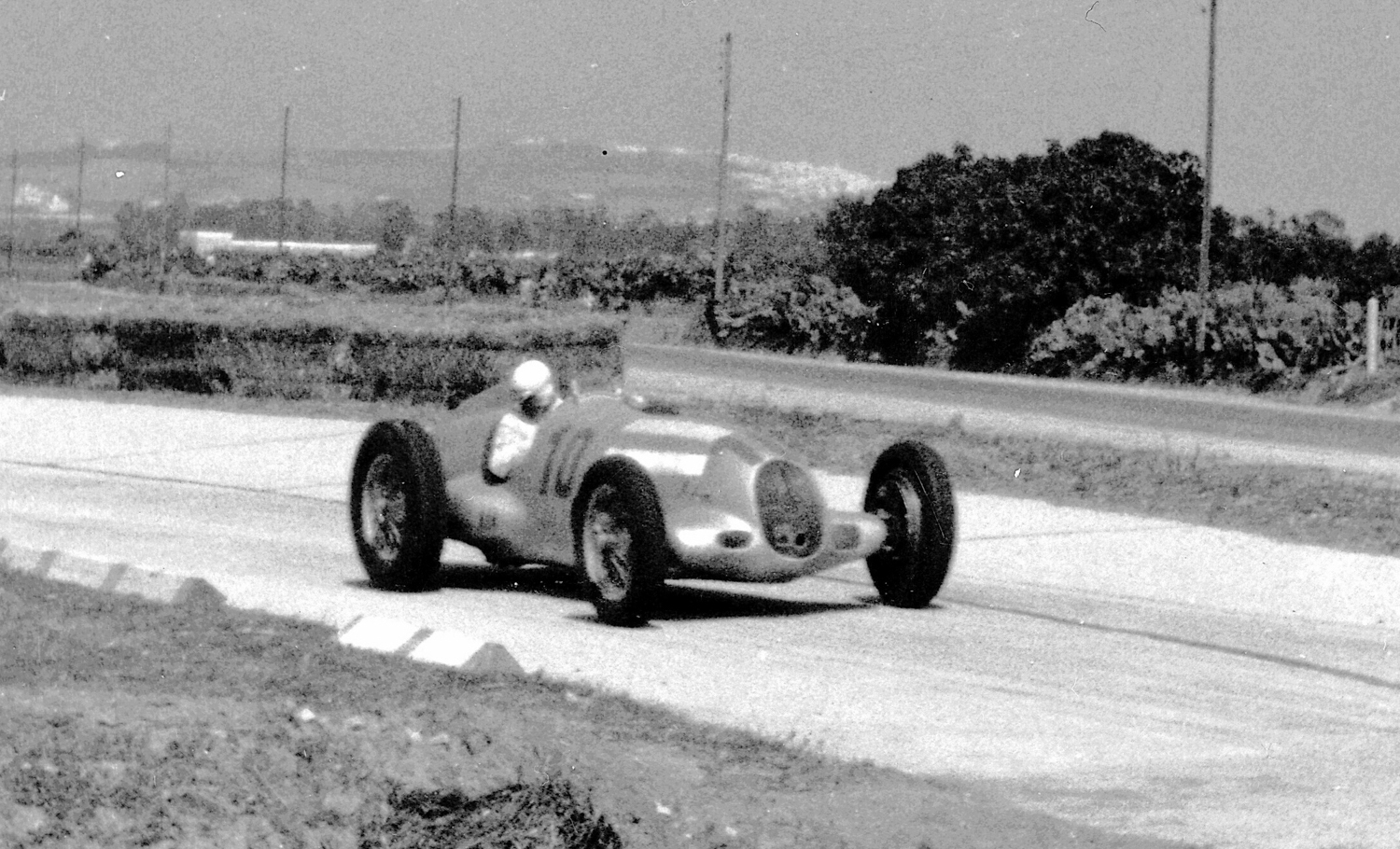
The uncomfortable Manfred stopped on the circuit when his tank failed to feed all its fuel, a problem noted in the Monza trials but not rectified. And both Fagioli and Caracciola lost their front brakes after a pipe failure caused by the new mounting of the front-circuit master cylinder on the right-rear engine bearer.
The drivers found their cars very sensitive to the windy conditions on race day. Observing out on the course, Jakob Krauss thought they looked less steady on the turns than the Auto Unions. “Perhaps,” mused Neubauer afterward, “the longer chassis is better for fast courses.”
A victory was achieved in another race in North Africa, at Tunis, when the leading Auto Unions crashed and burned. It was the last win to fall to Rudy Caracciola and the W25K Mercedes Benz.
At Barcelona Nuvolari’s Alfa beat the new cars in a straight fight. Here the sharp pitching tendency of the shorter chassis was especially bothersome. Pitching was also a problem at the subsequent Eifelrennen that saw all but two of the cars retiring and those finishing well back. Engine trouble struck there and in the subsequent race at Budapest, where all the Mercedes-Benzes failed.
The new engine, pushed hard at last, had shown a critical frailty. Cylinders in the forward block were too weak to handle the high specific output and had begun to fail. First the existing parts were strengthened, then completely new cylinders and blocks were made for the all-important German Grand Prix in late July. Before that race several of the engines were switched from 240 mm to 255 mm superchargers, two of which subsequently broke. Chiron crashed and one car limped home sixth.
After such a run of disasters any sporting team determined to be victorious would call a rapid halt and make some changes. So too it was with Daimler-Benz. The organization that had served it so well since automobile racing began was apparently no longer equal to the pace and intensity of Grand Prix racing in the 1930s.
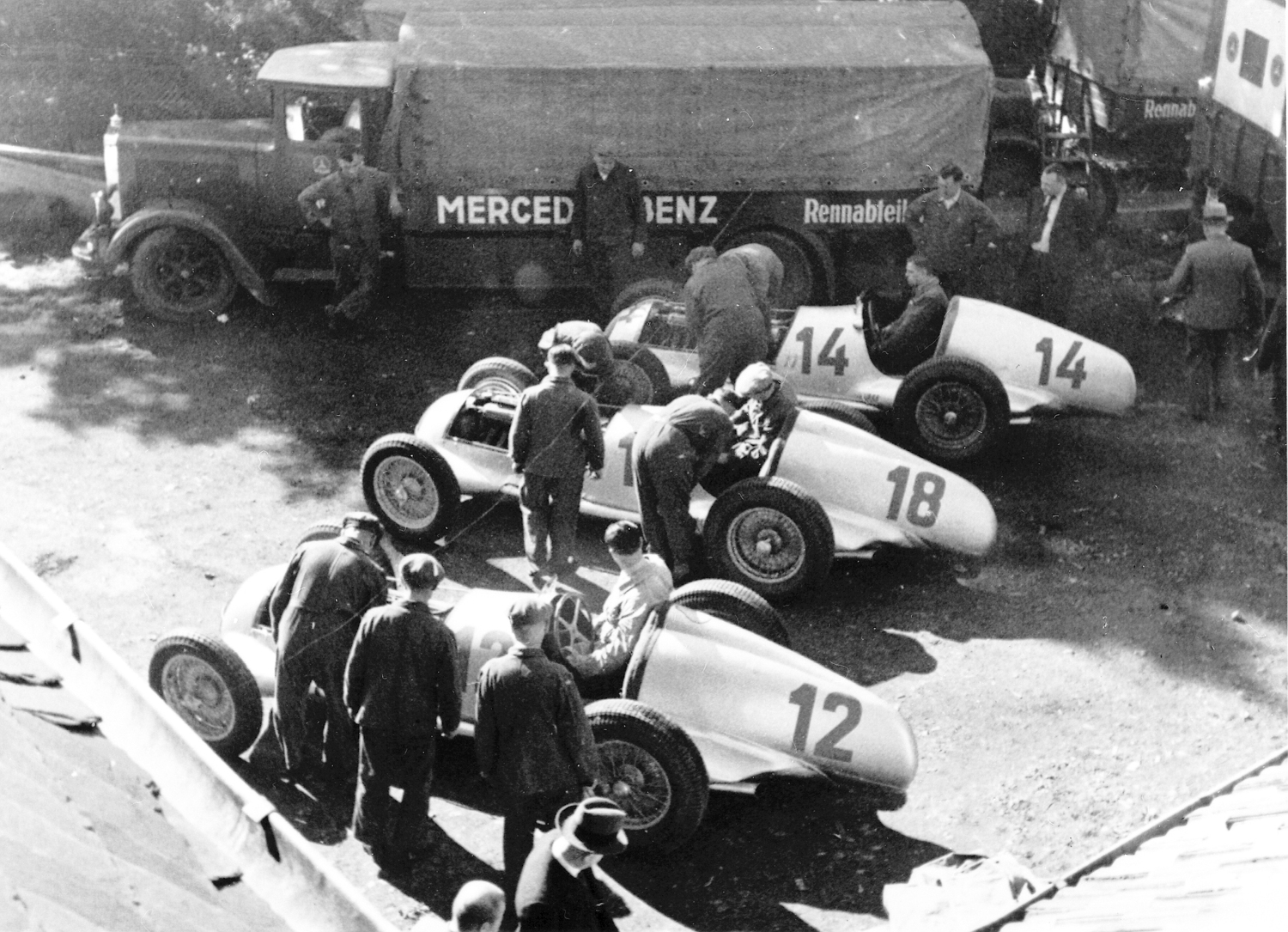
The liaison between Alfred Neubauer’s Sports Department and the engineers in the central design office had always been direct. This changed with the creation of a new technical body that was specifically concerned with the racing cars. An offshoot of the Experimental Separtment, it was called the Rennabteilung, the Racing Department.
Placed in charge of it was a handsome young man who had been with the company only five years. Born of a German father and British mother, he had joined Daimler-Benz directly from engineering school as a carburetion specialist in the Experimental Department. The young man, whose arrival on the scene can only be described as marking a turning point in the racing history of Daimler-Benz, was Rudolf Uhlenhaut.
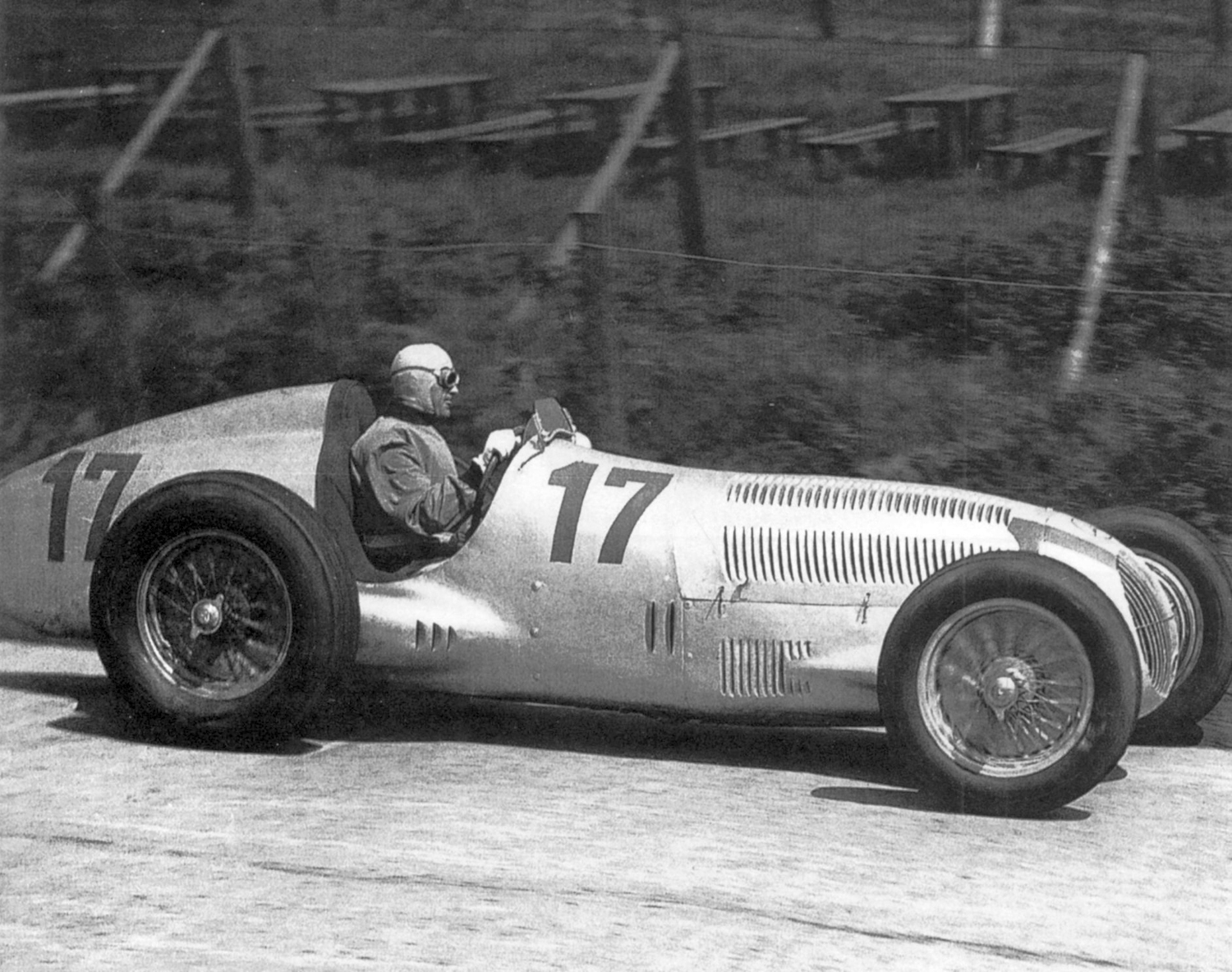
Uhlenhaut’s new group was made fully responsible for assembling, preparing and testing the cars, then turning them over to Neubauer’s sporting department for racing. Reporting directly to Fritz Nallinger, who headed the main Experimental Department, he was assigned the services of Jakob Krauss in charge of car construction and Georg Scheerer as head of testing and inspection.
“Naturally we had a good design office,” Uhlenhaut said, “but the people there were cautious and our opinions often differed. However, if I wanted something I said so and they would generally let me have it.” He and his colleagues said what they wanted in their recommendations and requirements, expressed from mid-1936 onward in a blizzard of reports, memos and analyses generated by the new Rennabteilung.
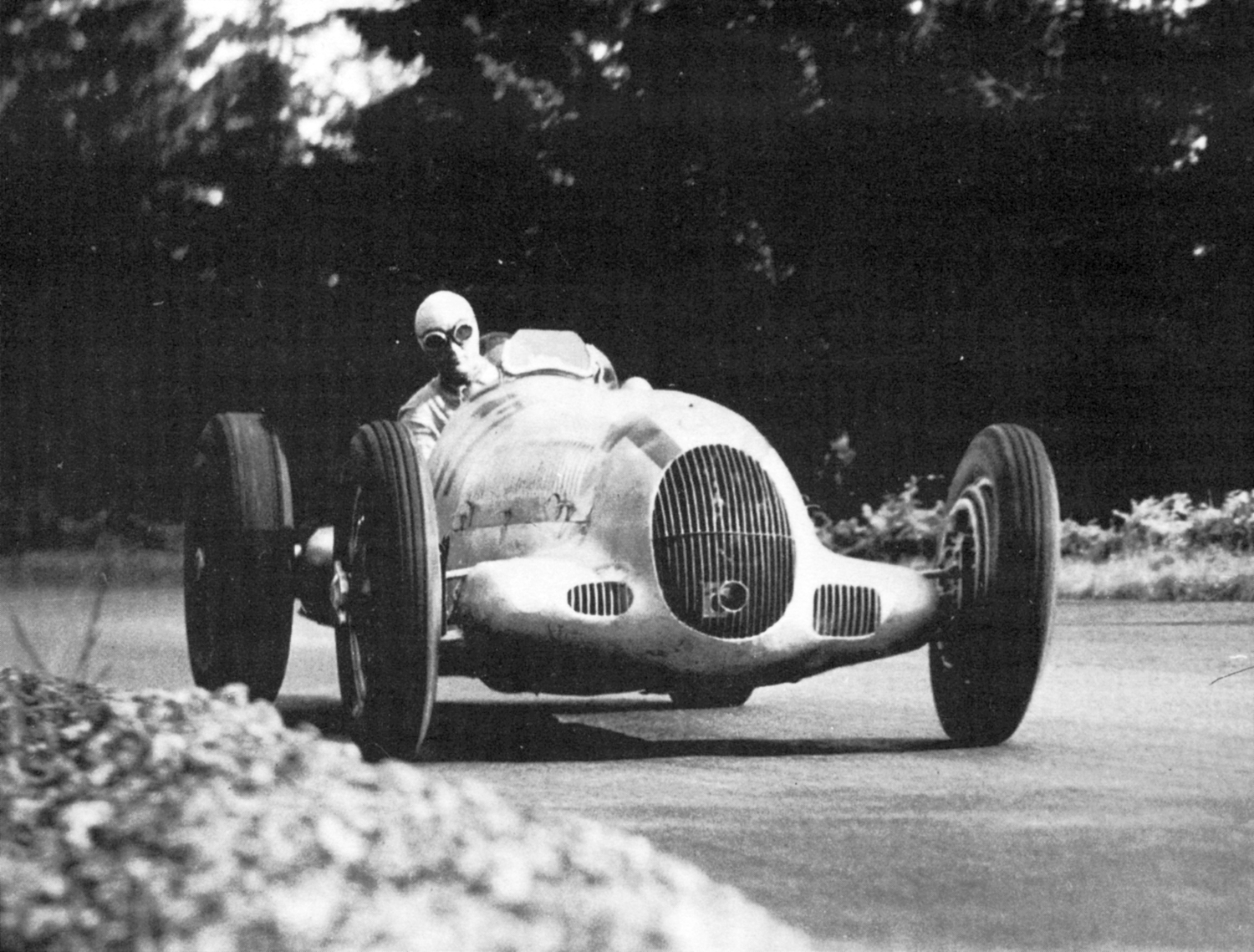
It was too late to do much about the W25K, which Uhlenhaut tested extensively at the Nürburgring. Race entries at Montenero and Pescara were abandoned to try to get the cars ready for the Swiss G.P. on August 23rd. There Fagioli broke a connecting rod, Caracciola broke the right side of his rear-axle tube and von Brauchitsch had cooling failure initiated by a piece of newspaper caught in front of the grille. Newcomer Hermann Lang eked out a finish in fourth place.
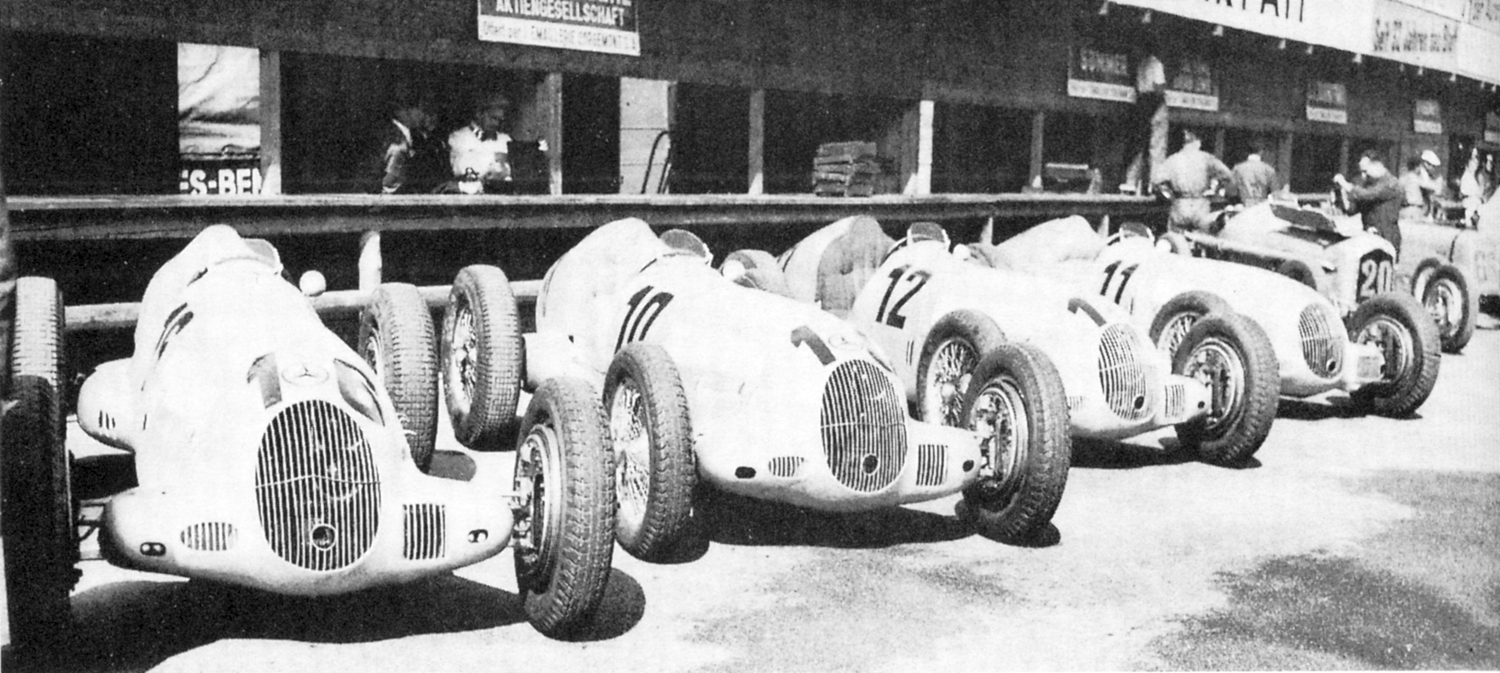
Caracciola had taken and held the lead—until Rosemeyer motored past him. “The drivers declared themselves as by and large satisfied with the roadholding, with empty as well as with full tanks,” Uhlenhaut recorded. “In this race it was clearly evident that the power of the Auto Union in the middle and upper speed ranges is far superior. To be able to hold the pace to some extent our drivers must constantly strain the engine to the limit and moreover attempt to gain back in the turns what they lose on the straights.

“A further participation in racing with the E motor seems to be useless,” Uhlenhaut concluded. Daimler-Benz management agreed with him. Entries for the Italian Grand Prix, the European season’s final event, were withdrawn. It was a heavy decision for the proud company. But the light shined on the technology of racing by Uhlenhaut’s new group would bring brilliant results in coming years.


